Zircons from a Pegmatite Cutting Eclogite (Gridino, Belomorian Mobile Belt): U-Pb-O and Trace Element Constraints on Eclogite Metamorphism and Fluid Activity
Abstract
1. Introduction
2. Geological Setting
3. Methods
4. Results
4.1. Zircon Characterization
4.2. Zircon U-Pb Geochronology
4.3. Zircon Oxygen Isotope Composition
4.4. Zircon Trace Element Composition
5. Discussion
5.1. Inter-Element Relationships
5.2. Anomalous Level of Non-Formula Elements in Zircon: The Role of Fluids Rich in Incompatible Elements
5.3. Granulite-Derived Zircons
5.4. Age Constraints
6. Conclusions
Supplementary Materials
Author Contributions
Funding
Acknowledgments
Conflicts of Interest
References
- Dokukina, K.A.; Bayanova, T.B.; Kaulina, T.V.; Travin, A.V.; Konilov, A.N. New geochronological data on metamorphic and igneous rocks from the Gridino Village area (Belomorian eclogitic province). Dokl. Earth Sci. 2010, 432, 671–676. [Google Scholar] [CrossRef]
- Dokukina, K.A.; Bayanova, T.B.; Kaulina, T.V.; Travin, A.V.; Mints, M.V.; Konilov, A.N.; Serov, P.A. The Belomorian eclogite province: Sequence of events and age of the igneous and metamorphic rocks of the Gridino association. Russ. Geol. Geophys. 2012, 53, 1023–1054. [Google Scholar] [CrossRef]
- Dokukina, K.A.; Konilov, A.N.; Van, K.V.; Mints, M.V.; Simakin, S.G. Origin of early paleoproterozoic zircons in rocks of the Archean eclogite association of Gridino (Belomorian eclogite province). Dokl. Earth Sci. 2012, 445, 832–839. [Google Scholar] [CrossRef]
- Dokukina, K.A.; Kaulina, T.V.; Konilov, A.N.; Mints, M.V.; Van, K.V.; Natapov, L.; Belousova, E.; Simakin, S.G.; Lepekhina, E.N. Archaean to Palaeoproterozoic high-grade evolution of the Belomorian eclogite province in the Gridino area, Fennoscandian Shield: Geochronological evidence. Gondwana Res. 2014, 25, 585–613. [Google Scholar] [CrossRef]
- Dokukina, K.A.; Konilov, A.N. Metamorphic evolution of the Gridino mafic dyke swarm (Belomorian eclogite province, Russia). In Ultrahigh-Pressure Metamorphism; Elsevier: Amsterdam, The Netherlands, 2011; pp. 579–621. [Google Scholar]
- Dokukina, K.; Mints, M. Subduction of the Mesoarchaean spreading ridge and related metamorphism, magmatism and deformation by the example of the Gridino eclogitized mafic dyke swarm, the Belomorian Eclogite Province, eastern Fennoscandian Shield. J. Geodyn. 2019, 123, 1–37. [Google Scholar] [CrossRef]
- Brown, M. The contribution of metamorphic petrology to understanding lithosphere evolution and geodynamics. Geosci. Front. 2014, 5, 553–569. [Google Scholar] [CrossRef]
- Yu, H.; Zhang, L.; Lanari, P.; Rubatto, D.; Li, X. Garnet Lu-Hf geochronology and P-T path of the Gridino-type eclogite in the Belomorian Province, Russia. Lithos 2019, 326, 313–326. [Google Scholar] [CrossRef]
- Volodichev, O.I.; Slabunov, A.I.; Bibikova, E.V.; Konilov, A.N.; Kuzenko, T.I. Archean eclogites in the Belomorian mobile belt, Baltic Shield. Petrology 2004, 12, 540–560. [Google Scholar]
- Li, X.; Zhang, L.; Wei, C.; Slabunov, A.I. Metamorphic PT path and zircon U–Pb dating of Archean eclogite association in Gridino complex, Belomorian province, Russia. Precambrian Res. 2015, 268, 74–96. [Google Scholar] [CrossRef]
- Skublov, S.G.; Astaf’ev, B.Y.; Marin, Y.B.; Berezin, A.V.; Mel’nik, A.E.; Presnyakov, S.L. New data on the age of eclogites from the Belomorian mobile belt at Gridino settlement area. Dokl. Earth Sci. 2011, 439, 1163–1170. [Google Scholar] [CrossRef]
- Skublov, S.G.; Berezin, A.V.; Berezhnaya, N.G. General relations in the trace-element composition of zircons from eclogites with implications for the age of eclogites in the Belomorian Mobile Belt. Petrology 2012, 20, 427–449. [Google Scholar] [CrossRef]
- Travin, V.V.; Kozlova, N.E. Eclogitization of basites in early proterozoic shear zones in the area of the village of Gridino, western Belomorie. Petrology 2009, 17, 684–706. [Google Scholar] [CrossRef]
- Skublov, S.G.; Berezin, A.V.; Melnik, A.E.; Astafiev, B.Y.; Voinova, O.A.; Alekseev, V.I. Protolith age of eclogites from the southern part of Pezhostrov Island, Belomorian belt: Protolith of metabasites as indicator of eclogitization time. Petrology 2016, 24, 594–607. [Google Scholar] [CrossRef]
- Berezin, A.V.; Travin, V.V.; Marin, Y.B.; Skublov, S.G.; Bogomolov, E.S. New U-Pb and Sm-Nd ages and P-T estimates for eclogitization in the Fe-rich gabbro dyke in Gridino area (Belomorian Mobile Belt). Dokl. Earth Sci. 2012, 444, 760–765. [Google Scholar] [CrossRef]
- Li, X.; Yu, H.; Zhang, L.; Wei, C.; Bader, T. 1.9 Ga eclogite from the Archean-Paleoproterozoic Belomorian Province, Russia. Sci. Bull. 2017, 62, 239–241. [Google Scholar] [CrossRef]
- Yu, H.L.; Zhang, L.F.; Wei, C.J.; Li, X.L.; Guo, J.H. Age and P–T conditions of the Gridino-type eclogite in the Belomorian Province, Russia. J. Metamorph. Geol. 2017, 35, 855–869. [Google Scholar] [CrossRef]
- Skublov, S.G.; Balashov, Y.A.; Marin, Y.B.; Berezin, A.V.; Mel’nik, A.E.; Paderin, I.P. U-Pb age and geochemistry of zircons from Salma eclogites (Kuru-Vaara deposit, Belomorian Belt). Dokl. Earth Sci. 2010, 432, 791–798. [Google Scholar] [CrossRef]
- Skublov, S.G.; Berezin, A.V.; Marin, Y.B.; Rizvanova, N.G.; Bogomolov, E.S.; Sergeeva, N.A.; Vasil’eva, I.M.; Guseva, V.F. Complex isotopic-geochemical (Sm-Nd, U-Pb) study of Salma eclogites. Dokl. Earth Sci. 2010, 434, 1396–1400. [Google Scholar] [CrossRef]
- Skublov, S.G.; Berezin, A.V.; Mel’nik, A.E. Paleoproterozoic eclogites in the Salma Area, Northwestern Belomorian mobile belt: Composition and isotopic geochronologic characteristics of minerals and metamorphic age. Petrology 2011, 19, 470–495. [Google Scholar] [CrossRef]
- Herwartz, D.; Skublov, S.G.; Berezin, A.V.; Mel’nik, A.E. First Lu-Hf garnet ages of eclogites from the Belomorian mobile belt (Baltic shield, Russia). Dokl. Earth Sci. 2012, 443, 377–380. [Google Scholar] [CrossRef]
- Skublov, S.G.; Marin, Y.B.; Galankina, O.L.; Simakin, S.G.; Myskova, T.M.; Astaf’ev, B.Y. The first discovery of abnormal (Y+REE)-enriched zircons in rocks of the Baltic Shield. Dokl. Earth Sci. 2011, 441, 1724–1731. [Google Scholar] [CrossRef]
- Stepanova, A.; Stepanov, V. Paleoproterozoic mafic dyke swarms of the Belomorian Province, eastern Fennoscandian Shield. Precambrian Res. 2010, 183, 602–616. [Google Scholar] [CrossRef]
- Travin, V.V. The structural position and age of eclogite rocks in the area of Gridino village in the Belomorian mobile belt. Geotectonics 2015, 49, 425–438. [Google Scholar] [CrossRef]
- Travin, V.V.; Kozlova, N.E. Local shear deformations as a cause of eclogitization: Evidence from the Gridino melange zone, Belomorian Mobile Belt. Dokl. Earth Sci. 2005, 405, 1275–1278. [Google Scholar]
- Black, L.P.; Kamo, S.L.; Allen, C.M.; Davis, D.W.; Aleinikoff, J.N.; Valley, J.W.; Mundil, R.; Campbell, I.H.; Korsch, R.J.; Williams, I.S.; et al. Improved 206Pb/238U microprobe geochronology by the monitoring of a trace-element-related matrix effect; SHRIMP, ID–TIMS, ELA–ICP–MS and oxygen isotope documentation for a series of zircon standards. Chem. Geol. 2004, 205, 115–140. [Google Scholar] [CrossRef]
- Wiedenbeck, M.; Alle, P.; Corfu, F.; Griffin, W.L.; Meier, M.; Oberli, F.; von Quadt, A.; Roddick, J.C.; Spiegel, W. Three natural zircon standards for U-Th-Pb, Lu-Hf, trace element and REE analyses. Geostand. Newsl. 1995, 19, 1–23. [Google Scholar] [CrossRef]
- Li, X.H.; Liu, Y.; Li, Q.L.; Guo, C.H.; Chamberlain, K.R. Precise determination of Phanerozoic zircon Pb/Pb age by multicollector SIMS without external standardization. Geochem. Geophys. Geosystems 2009, 10, 1–21. [Google Scholar]
- Wiedenbeck, M.; Hanchar, J.M.; Peck, W.H.; Sylvester, P.; Valley, J.; Whitehouse, M.; Kronz, A.; Morishita, Y.; Nasdala, L.; Fiebig, J. Further characterisation of the 91500 zircon crystal. Geostand. Geoanalytical Res. 2004, 28, 9–39. [Google Scholar] [CrossRef]
- Li, Q.-L.; Li, X.-H.; Liu, Y.; Tang, G.-Q.; Yang, J.-H.; Zhu, W.-G. Precise U–Pb and Pb–Pb dating of Phanerozoic baddeleyite by SIMS with oxygen flooding technique. J. Anal. At. Spectrom. 2010, 25, 1107–1113. [Google Scholar] [CrossRef]
- Ludwig, K.R. Isoplot/Ex version 2.49: A geochronology toolkit for Microsoft Excel. Berkeley Geochronol. Cent. Spec. Publ. 2001, 55. [Google Scholar]
- Li, X.H.; Long, W.G.; Li, Q.L.; Liu, Y.; Zheng, Y.F.; Yang, Y.H.; Chamberlain, K.R.; Wan, D.F.; Guo, C.H.; Wang, X.C.; et al. Penglai zircon megacrysts: A potential new working reference material for microbeam determination of Hf–O isotopes and U–Pb age. Geostand. Geoanalytical Res. 2010, 34, 117–134. [Google Scholar] [CrossRef]
- Tang, G.-Q.; Li, X.-H.; Li, Q.-L.; Liu, Y.; Ling, X.-X.; Yin, Q.-Z. Deciphering the physical mechanism of the topography effect for oxygen isotope measurements using a Cameca IMS-1280 SIMS. J. Anal. At. Spectrom. 2015, 30, 950–956. [Google Scholar] [CrossRef]
- Fedotova, A.A.; Bibikova, E.V.; Simakin, S.G. Ion-microprobe zircon geochemistry as an indicator of mineral genesis during geochronological studies. Geochem. Int. 2008, 46, 912–927. [Google Scholar] [CrossRef]
- McDonough, W.F.; Sun, S.S. The composition of the Earth. Chem. Geol. 1995, 120, 223–253. [Google Scholar] [CrossRef]
- Watson, E.B.; Wark, D.A.; Thomas, J.B. Crystallization thermometers for zircon and rutile. Contrib. Mineral. Petrol. 2006, 151, 413–433. [Google Scholar] [CrossRef]
- Harley, S.L.; Kelly, N.M. Zircon tiny but timely. Elements 2007, 3, 13–18. [Google Scholar] [CrossRef]
- Hoskin, P.W.O.; Schaltegger, U. The composition of zircon and igneous and metamorphic petrogenesis. Rev. Mineral. Geochem. 2003, 53, 27–62. [Google Scholar] [CrossRef]
- Jahns, R.H.; Burnham, C.W. Experimental studies of pegmatite genesis; l, A model for the derivation and crystallization of granitic pegmatites. Econ. Geol. 1969, 64, 843–864. [Google Scholar] [CrossRef]
- Finch, R.J.; Hanchar, J.M. Structure and chemistry of zircon and zircon-group minerals. Rev. Mineral. Geochem. 2003, 53, 1–25. [Google Scholar] [CrossRef]
- Makeyev, A.B.; Skublov, S.G. Y–REE-rich zircons of the Timan region: Geochemistry and economic significance. Geochem. Int. 2016, 54, 788–794. [Google Scholar] [CrossRef]
- De Hoog, J.C.M.; Lissenberg, C.J.; Brooker, R.A.; Hinton, R.; Trail, D.; Hellebrand, E. Hydrogen incorporation and charge balance in natural zircon. Geochim. Cosmochim. Acta 2014, 141, 472–486. [Google Scholar] [CrossRef]
- Fu, B.; Page, F.Z.; Cavosie, A.J.; Fournelle, J.; Kita, N.T.; Lackey, J.S.; Wilde, S.A.; Valley, J.W. Ti-in-zircon thermometry: Applications and limitations. Contrib. Mineral. Petrol. 2008, 156, 197–215. [Google Scholar] [CrossRef]
- Horie, K.; Hidaka, H.; Gauthier-Lafaye, F. Elemental distribution in zircon: Alteration and radiation-damage effects. Phys. Chem. Earth, Parts A/B/C 2006, 31, 587–592. [Google Scholar] [CrossRef]
- Hay, D.C.; Dempster, T.J. Zircon behaviour during low-temperature metamorphism. J. Petrol. 2009, 50, 571–589. [Google Scholar] [CrossRef]
- Levashova, E.V.; Skublov, S.G.; Marin, Y.B.; Li, X.-H.; Petrov, D.A.; Krivdik, S.G.; Lupashko, T.M.; Il’chenko, K.O.; Tyuleneva, N.V.; Alekseev, V.I. New data on zircon geochemistry and age (U-Pb, SHRIMP II) of the Yastrebetskoe Zr-REE-Y deposit, Ukrainian shield. Geochem. Int. 2015, 53, 572–579. [Google Scholar] [CrossRef]
- Skublov, S.G.; Li, X.-H. Anomalous geochemistry of zircon from the Yastrebetskoe rare metal deposit (SIMS- and TOF-study). J. Min. Inst. 2016, 222, 798–802. [Google Scholar]
- Hoshino, M.; Watanabe, Y.; Murakami, H.; Kon, Y.; Tsunematsu, M. Formation process of zircon associated with REE-fluorocarbonate and niobium minerals in the Nechalacho REE Deposit, Thor Lake, Canada. Resour. Geol. 2013, 63, 1–26. [Google Scholar] [CrossRef]
- Levskii, L.K.; Skublov, S.G.; Gembitskaya, I.M. Isotopic-geochemical study of zircons from metabasites of the Kontokki dike complex: Age of regional metamorphism in the Kostomuksha structure. Petrology 2009, 17, 669–683. [Google Scholar] [CrossRef]
- Skublov, S.G.; Lobach-Zhuchenko, S.B.; Guseva, N.S.; Gembitskaya, I.M.; Tolmacheva, E.V. Rare earth and trace element distribution in zircons from miaskite lamproites of the Panozero Complex, Central Karelia. Geochem. Int. 2009, 47, 901–913. [Google Scholar] [CrossRef]
- Jiang, S.-Y.; Wang, R.-C.; Xu, X.-S.; Zhao, K.-D. Mobility of high field strength elements (HFSE) in magmatic-, metamorphic-, and submarine-hydrothermal systems. Phys. Chem. Earth, Parts A/B/C 2005, 30, 1020–1029. [Google Scholar] [CrossRef]
- Geisler, T.; Schleicher, H. Improved U–Th–total Pb dating of zircons by electron microprobe using a simple new background modeling procedure and Ca as a chemical criterion of fluid-induced U-Th-Pb discordance in zircon. Chem. Geol. 2000, 163, 269–285. [Google Scholar] [CrossRef]
- Geisler, T.; Schaltegger, U.; Tomaschek, F. Re-equilibration of zircon in aqueous fluids and melts. Elements 2007, 3, 43–50. [Google Scholar] [CrossRef]
- Pettke, T.; Audétat, A.; Schaltegger, U.; Heinrich, C.A. Magmatic-to-hydrothermal crystallization in the W–Sn mineralized Mole Granite (NSW, Australia): Part II: Evolving zircon and thorite trace element chemistry. Chem. Geol. 2005, 220, 191–213. [Google Scholar] [CrossRef]
- Fu, B.; Mernagh, T.P.; Kita, N.T.; Kemp, A.I.; Valley, J.W. Distinguishing magmatic zircon from hydrothermal zircon: A case study from the Gidginbung high-sulphidation Au–Ag–(Cu) deposit, SE Australia. Chem. Geol. 2009, 259, 131–142. [Google Scholar] [CrossRef]
- Hoskin, P.W. Trace-element composition of hydrothermal zircon and the alteration of Hadean zircon from the Jack Hills, Australia. Geochim. Cosmochim. Acta 2005, 69, 637–648. [Google Scholar] [CrossRef]
- Grimes, C.B.; John, B.E.; Cheadle, M.J.; Mazdab, F.K.; Wooden, J.L.; Swapp, S.; Schwartz, J.J. On the occurrence, trace element geochemistry, and crystallization history of zircon from in situ ocean lithosphere. Contrib. Mineral. Petrol. 2009, 158, 757–783. [Google Scholar] [CrossRef]
- Bouvier, A.-S.; Ushikubo, T.; Kita, N.T.; Cavosie, A.J.; Kozdon, R.; Valley, J.W. Li isotopes and trace elements as a petrogenetic tracer in zircon: Insights from Archean TTGs and sanukitoids. Contrib. Mineral. Petrol. 2012, 163, 745–768. [Google Scholar] [CrossRef]
- Rayner, N.; Stern, R.A.; Carr, S.D. Grain-scale variations in trace element composition of fluid-altered zircon, Acasta Gneiss Complex, northwestern Canada. Contrib. Mineral. Petrol. 2005, 148, 721–734. [Google Scholar] [CrossRef]
- Rubatto, D. Zircon trace element geochemistry: Partitioning with garnet and the link between U–Pb ages and metamorphism. Chem. Geol. 2002, 184, 123–138. [Google Scholar] [CrossRef]
- Yakymchuk, C.; Kirkland, C.L.; Clark, C. Th/U ratios in metamorphic zircon. J. Metamorph. Geol. 2018, 36, 715–737. [Google Scholar] [CrossRef]
- Balashov, Y.A.; Skublov, S.G. Contrasting geochemistry of magmatic and secondary zircons. Geochem. Int. 2011, 49, 594–604. [Google Scholar] [CrossRef]
- Möller, A.; O’Brien, P.J.; Kennedy, A.; Kröner, A. Polyphase zircon in ultrahigh-temperature granulites (Rogaland, SW Norway): Constraints for Pb diffusion in zircon. J. Metamorph. Geol. 2002, 20, 727–740. [Google Scholar] [CrossRef]
- Möller, A.; O’Brien, P.J.; Kennedy, A.; Kröner, A. Linking growth episodes of zircon and metamorphic textures to zircon chemistry: An example from the ultrahigh-temperature granulites of Rogaland (SW Norway). Geol. Soc. Lond. Spec. Publ. 2003, 220, 65–81. [Google Scholar] [CrossRef]
- Kaulina, T.V. Formation and Transformation of Zircon in Polymetamorphic Complexes; Publishing House of Geological Institute of Kola Science Centre of the Russian Academy of Sciences: Apatity, Russia, 2010; p. 145. [Google Scholar]
- Glebovitsky, V.A.; Sedova, I.S.; Berezhnaya, N.G.; Skublov, S.G.; Samorukova, L.M. Zircon from charnockite gneiss, charnockite, and leucosome of migmatite in the Nimnyr Block of the Aldan Shield. Geol. Ore Depos. 2015, 57, 552–569. [Google Scholar] [CrossRef]
- Hoskin, P.W.O.; Black, L.P. Metamorphic zircon formation by solid-state recrystallization of protolith igneous zircon. J. Metamorph. Geol. 2000, 18, 423–439. [Google Scholar] [CrossRef]
- Whitehouse, M.J.; Kamber, B.S. A rare earth element study of complex zircons from early Archaean Amıtsoq gneisses, Godthåbsfjord, south-west Greenland. Precambrian Res. 2003, 126, 363–377. [Google Scholar] [CrossRef]
- Vavra, G.; Gebauer, D.; Schmid, R.; Compston, W. Multiple zircon growth and recrystallization during polyphase Late Carboniferous to Triassic metamorphism in granulites of the Ivrea Zone (Southern Alps): An ion microprobe (SHRIMP) study. Contrib. Mineral. Petrol. 1996, 122, 337–358. [Google Scholar] [CrossRef]
- Vavra, G.; Schmid, R.; Gebauer, D. Internal morphology, habit and U-Th-Pb microanalysis of amphibolite-to-granulite facies zircons: Geochronology of the Ivrea Zone (Southern Alps). Contrib. Mineral. Petrol. 1999, 134, 380–404. [Google Scholar] [CrossRef]
- Corfu, F.; Hanchar, J.M.; Hoskin, P.W.O.; Kinny, P. Atlas of zircon textures. Rev. Mineral. Geochem. 2003, 53, 469–500. [Google Scholar] [CrossRef]
- Bhowmik, S.K.; Wilde, S.A.; Bhandari, A.; Basu Sarbadhikari, A. Zoned monazite and zircon as monitors for the thermal history of granulite terranes: An example from the Central Indian Tectonic Zone. J. Petrol. 2014, 55, 585–621. [Google Scholar] [CrossRef]
- Koreshkova, M.Y.; Downes, H.; Nikitina, L.P.; Vladykin, N.V.; Larionov, A.N.; Sergeev, S.A. Trace element and age characteristics of zircons in granulite xenoliths from the Udachnaya kimberlite pipe, Siberia. Precambrian Res. 2009, 168, 197–212. [Google Scholar] [CrossRef]
- Zhang, X.; Shi, R.; Huang, Q.; Liu, D.; Gong, X.; Chen, S.; Wu, K.; Yi, G.; Sun, Y.; Ding, L. Early Jurassic high-pressure metamorphism of the Amdo terrane, Tibet: Constraints from zircon U–Pb geochronology of mafic granulites. Gondwana Res. 2014, 26, 975–985. [Google Scholar] [CrossRef]
- Berezin, A.V.; Skublov, S.G.; Marin, Y.B.; Mel’nik, A.E.; Bogomolov, E.S. New occurrence of eclogite in the Belomorian Mobile Belt: Geology, metamorphic conditions, and isotope age. Dokl. Earth Sci. 2013, 448, 43–53. [Google Scholar] [CrossRef]
- Berezin, A.V.; Skublov, S.G. Eclogite-like apogabbro rocks in Sidorov and Bolshaya Ileika islands, Keret Archipelago, White Sea: Compositional characteristics, metamorphic age and conditions. Petrology 2014, 22, 234–254. [Google Scholar] [CrossRef]
- Skublov, S.G.; Mel’nik, A.E.; Marin, Y.B.; Berezin, A.V.; Bogomolov, E.S.; Ishmurzin, F.I. New data on the age (U-Pb, Sm-Nd) of metamorphism and a protolith of eclogite-like rocks from the Krasnaya Guba area, Belomorian belt. Dokl. Earth Sci. 2013, 453, 1158–1164. [Google Scholar] [CrossRef]
- Kozlovskii, V.M.; Aranovich, L.Y. Petrology and thermobarometry of eclogite rocks in the Krasnaya Guba dike field, Belomorian Mobile Belt. Petrology 2010, 18, 27–49. [Google Scholar] [CrossRef]
- Skublov, S.G.; Berezin, A.V.; Rizvanova, N.G.; Mel’nik, A.E.; Myskova, T.A. Multistage Svecofennian metamorphism: Evidence from the composition and U-Pb age of titanite from eclogites of the Belomorian Mobile Belt. Petrology 2014, 22, 381–388. [Google Scholar] [CrossRef]
- Skublov, S.G.; Azimov, P.Y.; Li, X.-H.; Glebovitskii, V.A.; Melnik, A.E. Polymetamorphism of the Chupa Sequence of the Belomorian mobile belt (Fennoscandia): Evidence from the isotope-geochemical (U-Pb, REE, O) study of zircon. Geochem. Int. 2017, 55, 47–59. [Google Scholar] [CrossRef]
- Bibikova, E.V.; Bogdanova, S.V.; Glebovitsky, V.A.; Claesson, S.; Skiold, T. Evolution of the Belomorian Belt: NORDSIM U-Pb zircon dating of the Chupa paragneisses, magmatism, and metamorphic stages. Petrology 2004, 12, 195–210. [Google Scholar]
- Slabunov, A.I.; Azimov, P.Y.; Glebovitskii, V.A.; Zhang, L.; Kevlich, V.I. Archaean and palaeoproterozoic migmatizations in the Belomorian Province, Fennoscandian Shield: Petrology, geochronology, and geodynamic settings. Dokl. Earth Sci. 2016, 467, 259–263. [Google Scholar] [CrossRef]
- Zinger, T.F.; Götze, J.; Levchenkov, O.A.; Shuleshko, I.K.; Yakovleva, S.Z.; Makeyev, A.F. Zircon in polydeformed and metamorphosed Precambrian granitoids from the White sea tectonic zone, Russia: Morphology, cathodoluminescence, and U-Pb chronology. Int. Geol. Rev. 1996, 38, 57–73. [Google Scholar] [CrossRef]
- Glebovitskii, V.A.; Zinger, T.F.; Belyatskii, B.V. The age of granulites and nappe formation in the Western White Sea belt. Dokl. Earth Sci. 2000, 371, 255–258. [Google Scholar]
- Levsky, L.K.; Morozova, I.M.; Levchenkov, O.A.; Baikova, V.S.; Bogomolov, E.S. Isotopic-geochronological systems in metamorphic rocks: Pon’goma Island, Belomorian mobile belt. Geochem. Int. 2009, 47, 215–230. [Google Scholar] [CrossRef]
- Levchenkov, O.A.; Volodichev, O.I.; Zinger, T.F.; Yakovleva, S.Z.; Makeev, A.F.; Shuleshko, I.K.; Kevlich, V.I. U-Pb ages of zircons from Al-rich gneisses of the Pongoma Bay area (Belomorian Mobile Belt, Baltic Shield). Dokl. Akad. Nauk -Ross. Akad. Nauk 2001, 377, 235–238. [Google Scholar]
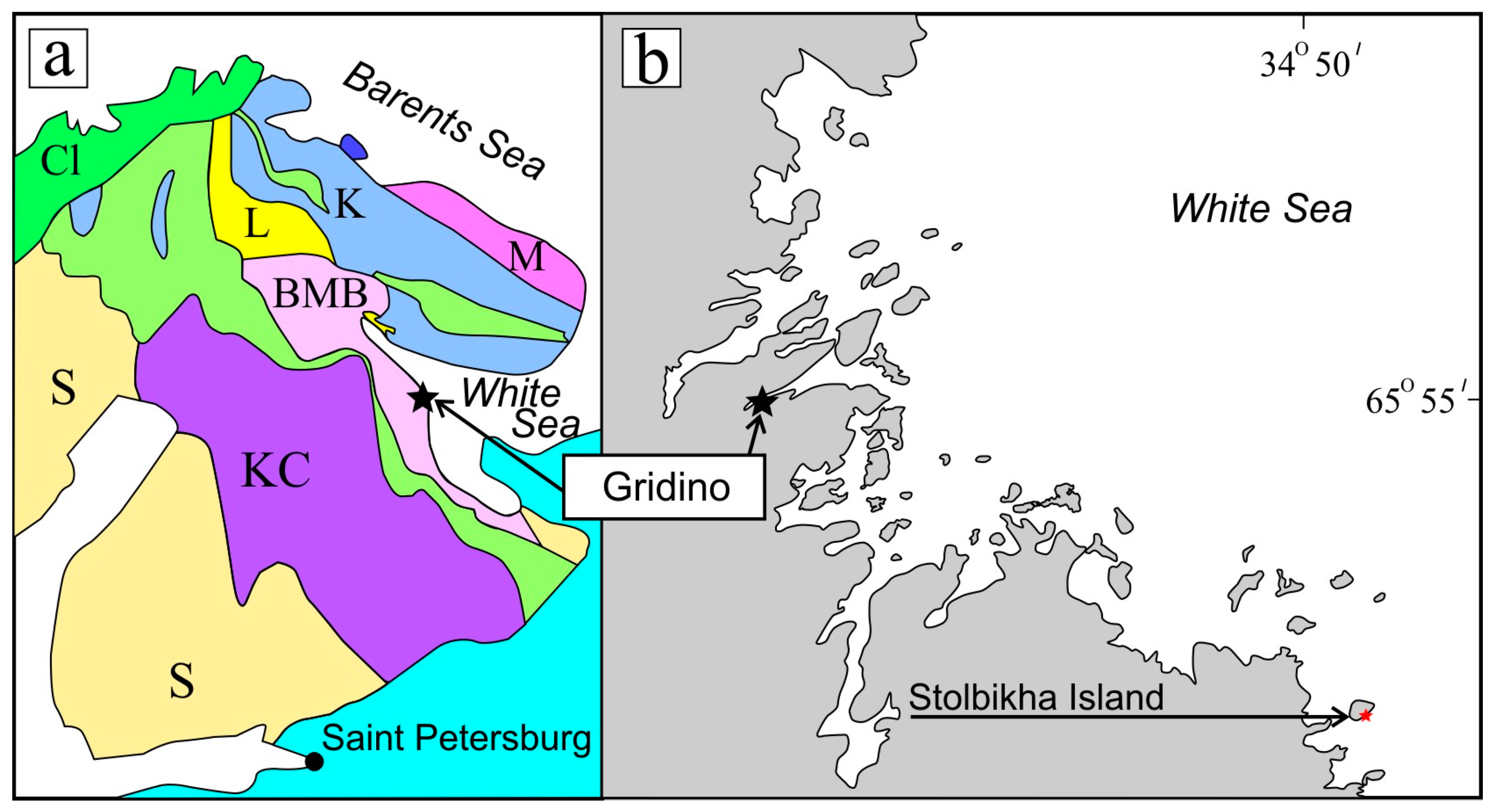
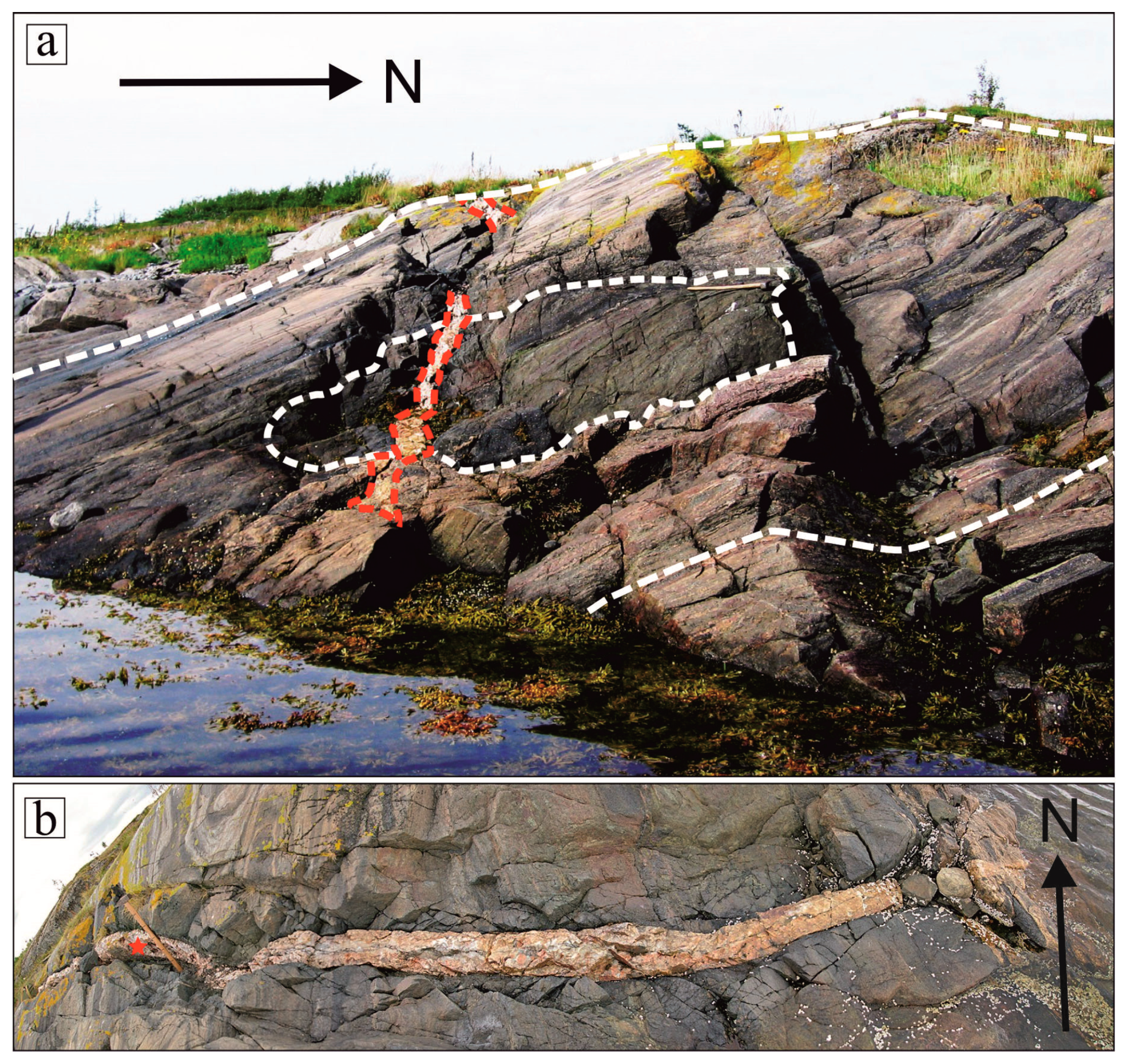
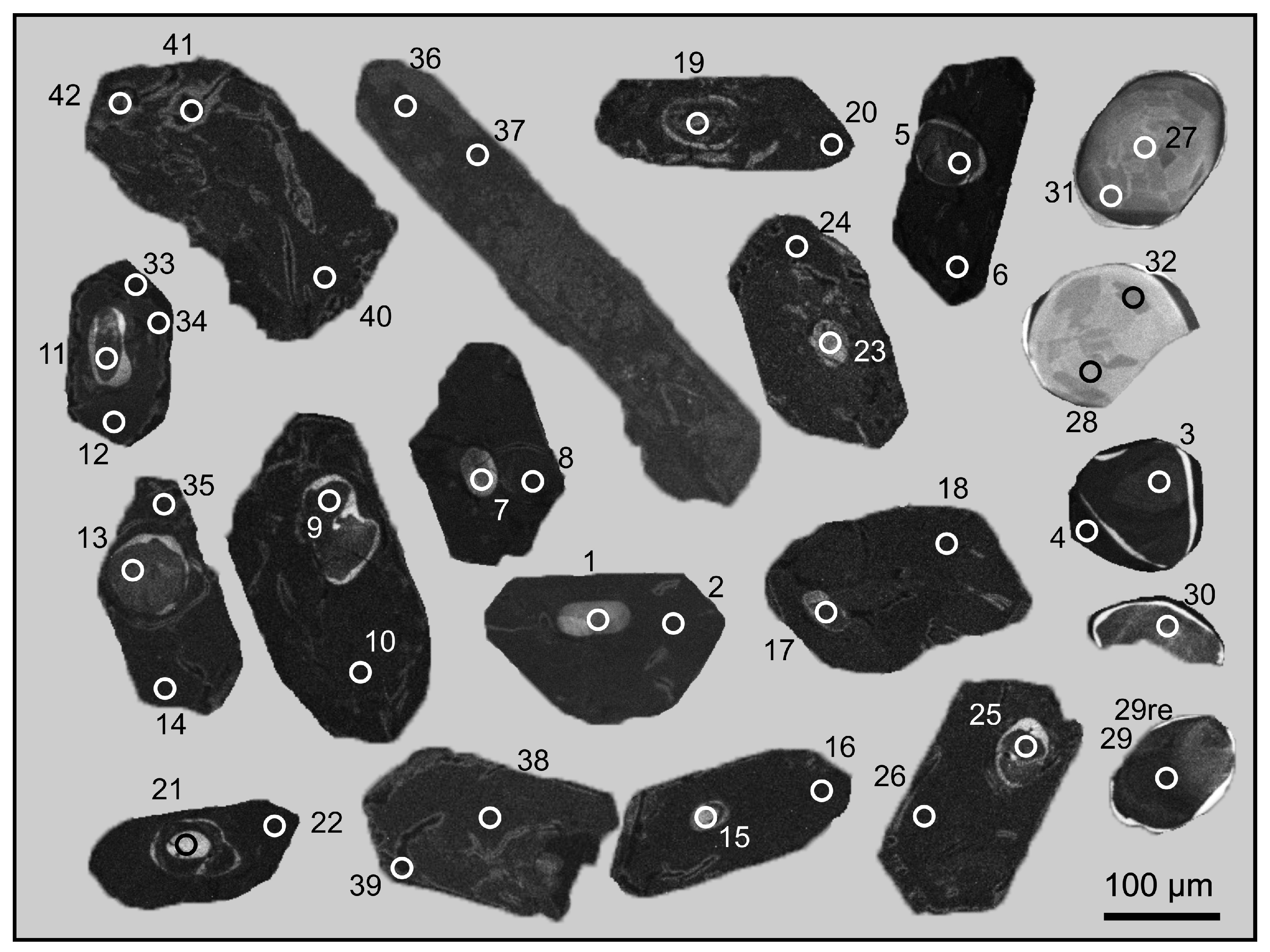
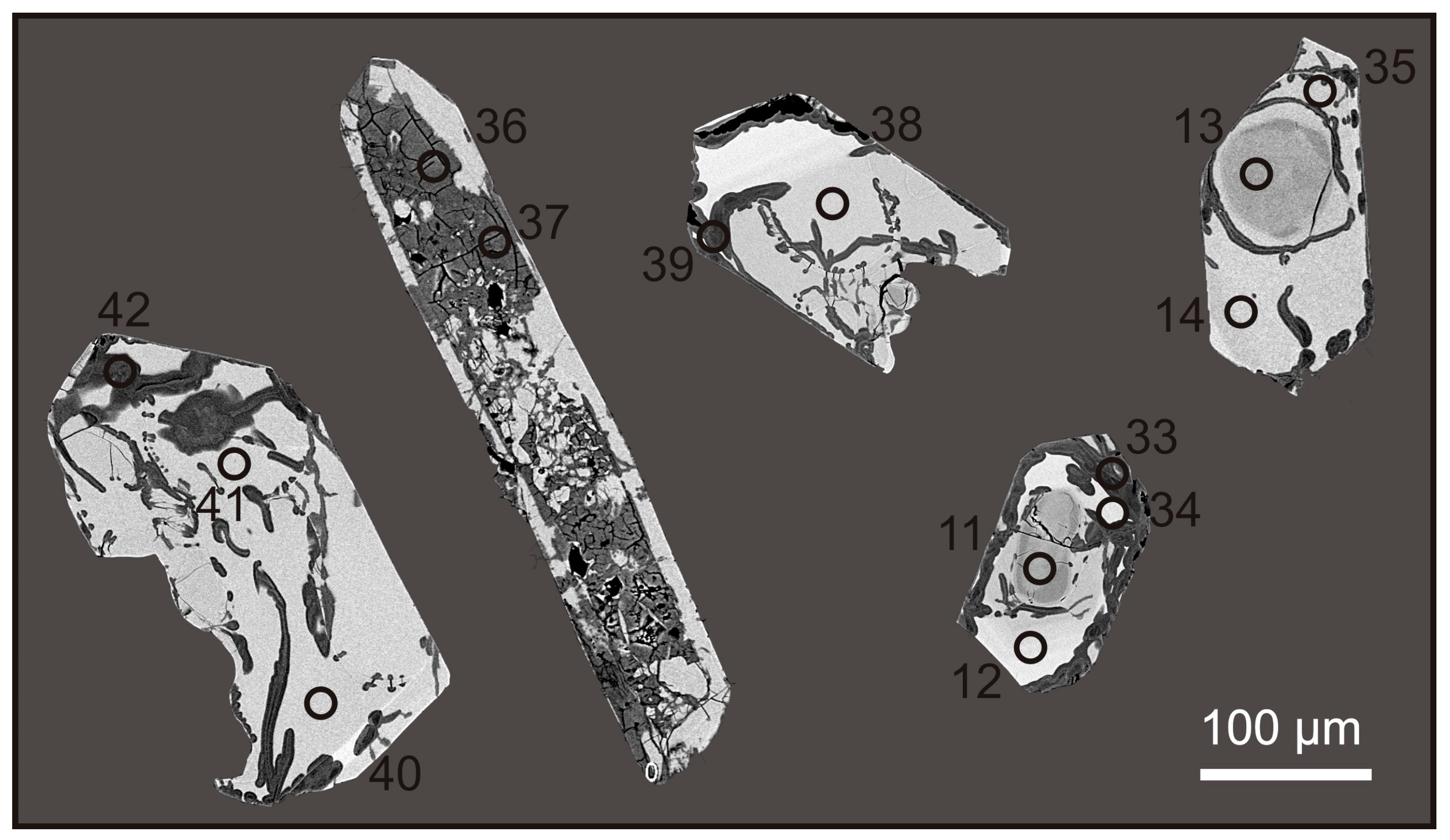
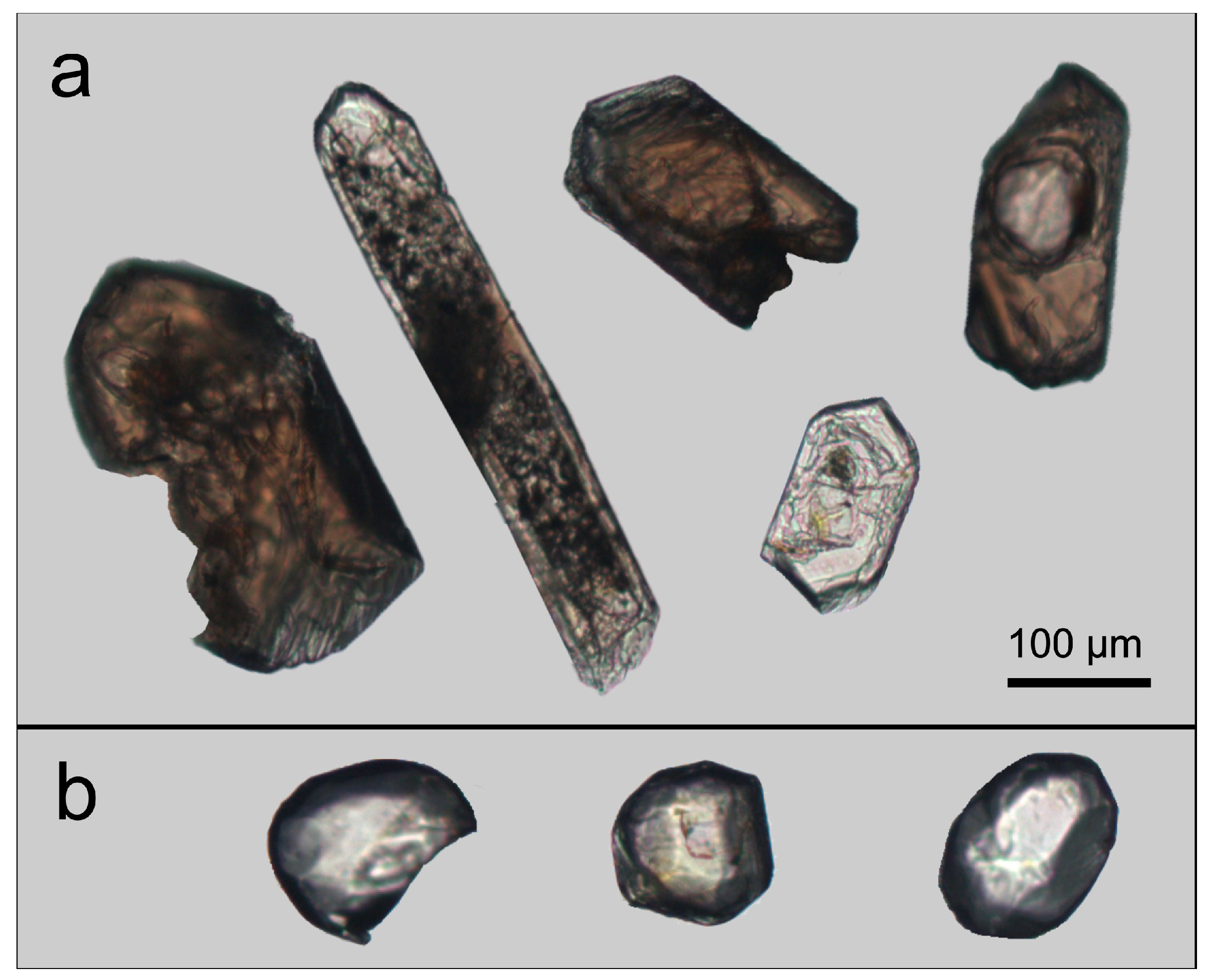
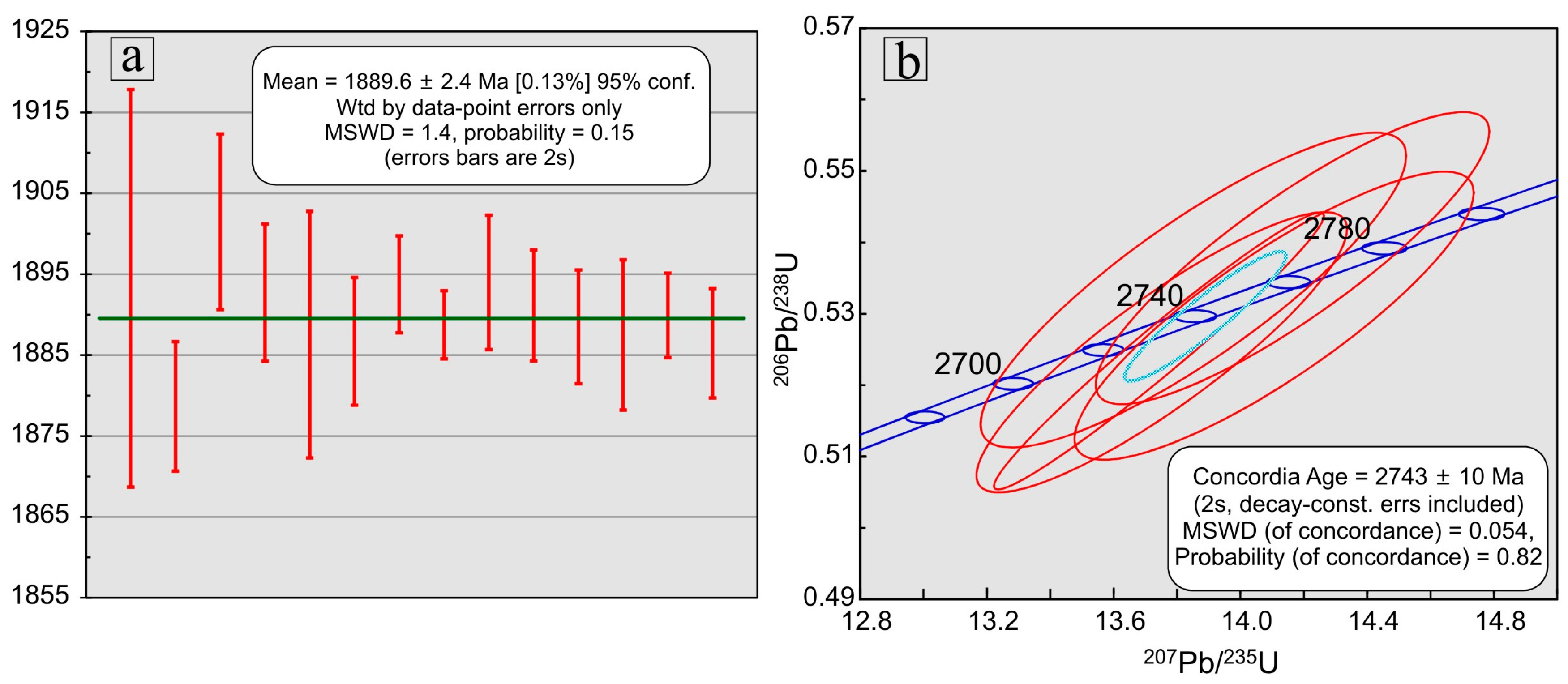
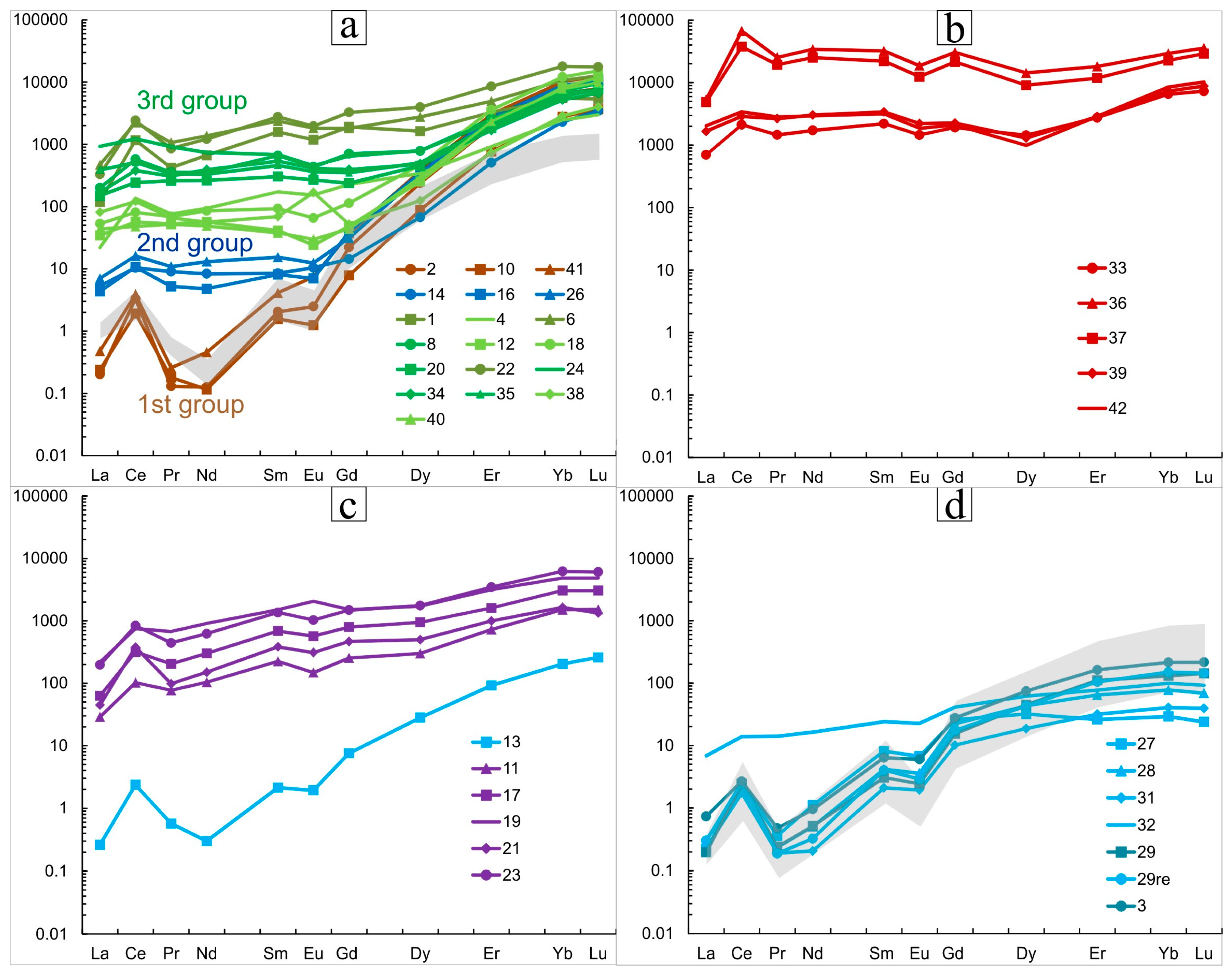
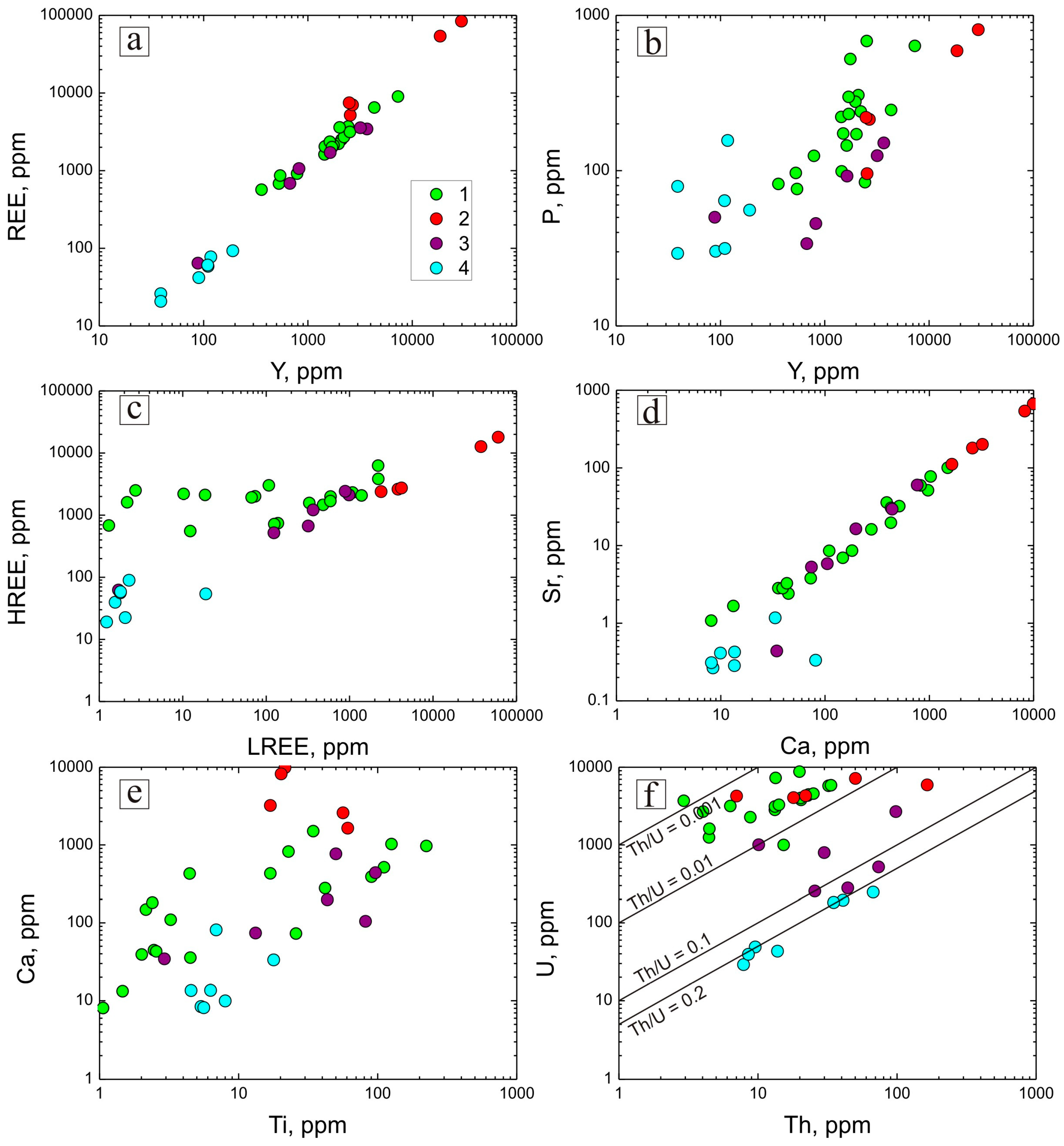
© 2020 by the authors. Licensee MDPI, Basel, Switzerland. This article is an open access article distributed under the terms and conditions of the Creative Commons Attribution (CC BY) license (http://creativecommons.org/licenses/by/4.0/).
Share and Cite
Skublov, S.G.; Berezin, A.V.; Li, X.-H.; Li, Q.-L.; Salimgaraeva, L.I.; Travin, V.V.; Rezvukhin, D.I. Zircons from a Pegmatite Cutting Eclogite (Gridino, Belomorian Mobile Belt): U-Pb-O and Trace Element Constraints on Eclogite Metamorphism and Fluid Activity. Geosciences 2020, 10, 197. https://doi.org/10.3390/geosciences10050197
Skublov SG, Berezin AV, Li X-H, Li Q-L, Salimgaraeva LI, Travin VV, Rezvukhin DI. Zircons from a Pegmatite Cutting Eclogite (Gridino, Belomorian Mobile Belt): U-Pb-O and Trace Element Constraints on Eclogite Metamorphism and Fluid Activity. Geosciences. 2020; 10(5):197. https://doi.org/10.3390/geosciences10050197
Chicago/Turabian StyleSkublov, Sergey G., Aleksey V. Berezin, Xian-Hua Li, Qiu-Li Li, Laysan I. Salimgaraeva, Veniamin V. Travin, and Dmitriy I. Rezvukhin. 2020. "Zircons from a Pegmatite Cutting Eclogite (Gridino, Belomorian Mobile Belt): U-Pb-O and Trace Element Constraints on Eclogite Metamorphism and Fluid Activity" Geosciences 10, no. 5: 197. https://doi.org/10.3390/geosciences10050197
APA StyleSkublov, S. G., Berezin, A. V., Li, X.-H., Li, Q.-L., Salimgaraeva, L. I., Travin, V. V., & Rezvukhin, D. I. (2020). Zircons from a Pegmatite Cutting Eclogite (Gridino, Belomorian Mobile Belt): U-Pb-O and Trace Element Constraints on Eclogite Metamorphism and Fluid Activity. Geosciences, 10(5), 197. https://doi.org/10.3390/geosciences10050197






